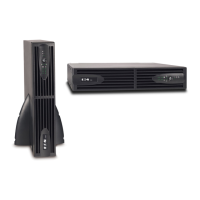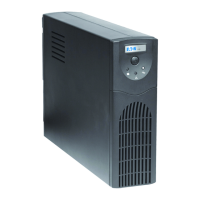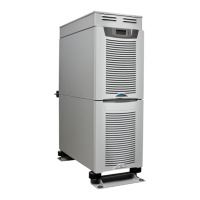UPS Installation Plan and Unpacking
Eaton
®
Power Xpert
®
9395P-900 UPS Installation and Operation Manual P-164000501—Rev 09 www.eaton.com/powerquality 3-19
Table 3-8. 480V Input/Output Ratings and External Wiring Requirements for the Three/Four UPM Models– Separate Battery
Basic Unit Rating
Units
Rating
50/60 Hz
Rating
50/60 Hz
Rating
50/60 Hz
Rating
50/60 Hz
Rating
50/60 Hz
kVA
kW
675
675
750
750
825
825
900
825
900
900
Input and Output Voltage Volts 480/480 480/480 480/480 480/480 480/480
AC Input to UPS Rectifier (0.98 Minimum pF)
Full load current plus battery recharge current
(3) Phases, (1) Ground
A
Amps 1002 1113 1225 1225 1336
Minimum Conductor Size
Number per Phase
AWG or
kcmil
(each)
500
(4)
500
(4)
500
(5)
500
(5)
500
(5)
AC Input to UPS Bypass
Full Load Current
(3) Phases, (1) Ground
B
Amps 812 902 992 1083 1083
Minimum Conductor Size
Number per Phase
AWG or
kcmil
(each)
500
(3)
500
(3)
500
(4)
500
(4)
500
(4)
DC Input from Battery Disconnect to Each UPS UPM
(1) Positive, (1) Negative
C
Amps
per
UPM
603 603 603 603 658
Minimum Conductor Size
Number per Pole
(1) Positive, (1) Negative
AWG or
kcmil
(each)
500
(3)
500
(3)
500
(3)
500
(3)
500
(3)
AC Output to Critical Load
Full Load Current
(3) Phases, (1) Ground
D
Amps 812 902 992 1083 1083
Minimum Conductor Size
Number per Pole
AWG or
kcmil
(each)
500
(3)
500
(3)
500
(4)
500
(4)
500
(4)
NOTE V Callout letters
A, B, C, and D map to Figure 6-6 on page 6-11
NOTE V If a 4-pole Automatic Transfer Switch (ATS) is used to connect the UPS to a generator or alternative input source, it may interrupt the
UPS input neutral during its transition between sources. For the 9395 UPS:
The ATS transition must be open in
both directions. The "break" time for the contacts must be at least 50 ms. This allows the UPS to
operate properly, however it is important to evaluate whether the critical load will function properly as its neutral reference is rapidly
(50 ms) switched. Note also that if the UPS load is on bypass, an ATS switchover with interruption of the neutral, will interrupt the
return current path and cause a loss of all phase-to-neutral loads.
If an overlapping neutral or make-before-break ATS switch is used, the neutrals must overlap for a minimum of 50 ms during the transition.

